Why you can trust Tom's Hardware
In our RTX 4060 Ti 16GB review, we added three additional (relatively) recent game releases to our testing, to see if they showed any additional benefit from the added memory. We're keeping those same games for the 7800/7700 XT reviews, and adding one more: Starfield — not because it's a balanced and well-optimized game, but because it does go into full release today, and we have some numbers from other GPUs, which you can see in our Starfield GPU performance guide, so we figured why not?
The other three games consist of F1 2023, Hogwarts Legacy, and The Last of Us: Part 1. None of these are brand-spanking new, and after the initial launch woes, most of them have received some much-needed TLC. But Hogwarts and The Last of Us still have a reputation for wanting more than 8GB of VRAM at maxed-out settings, and Starfield will give us a look at a brand-new game on current and previous generation AMD GPUs as well as Nvidia GPUs — caveats apply to Nvidia performance right now.
We'll do a gallery of the benchmarks from each game, so swipe through the images to see the results at the various settings/resolutions.

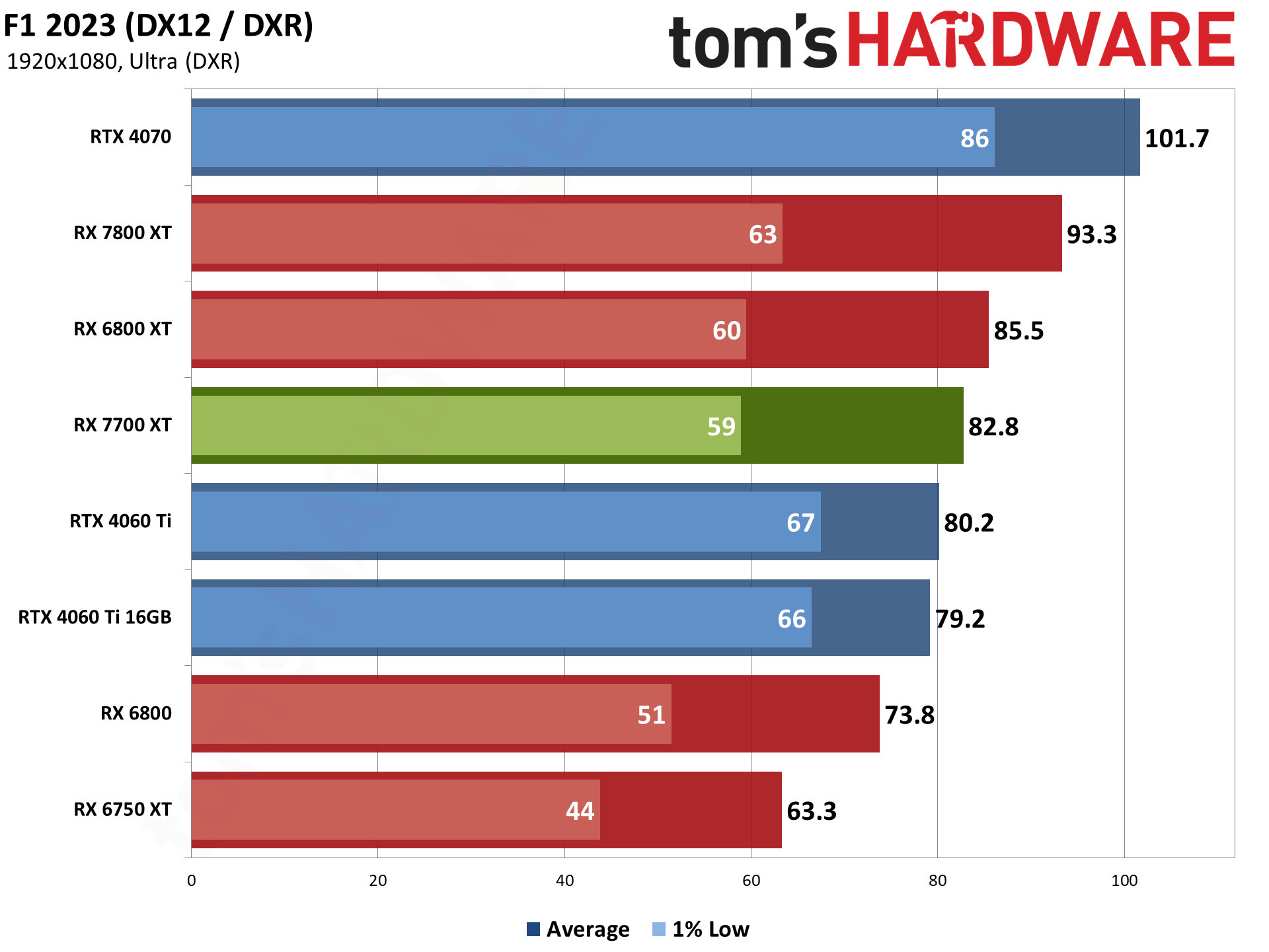
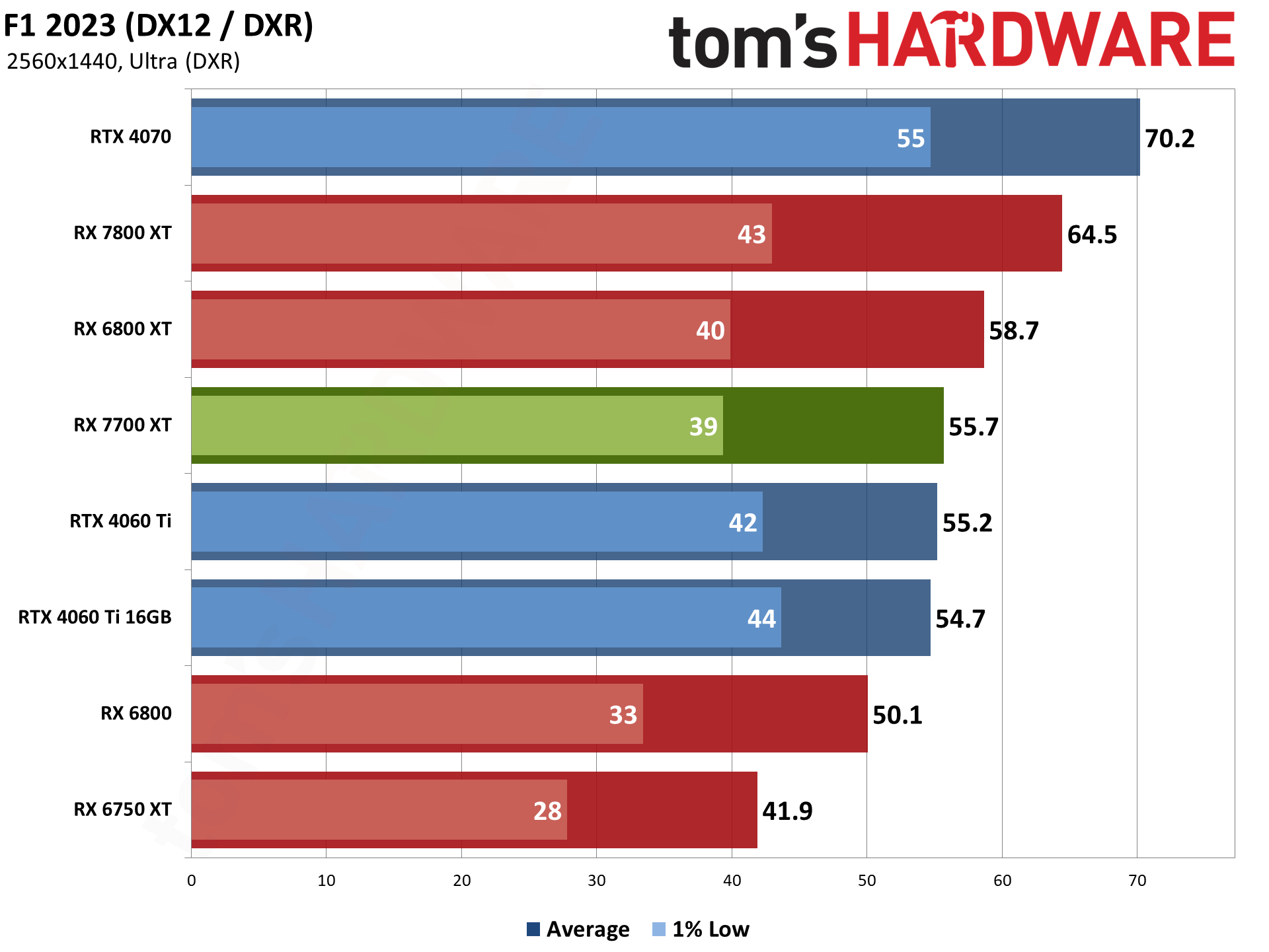
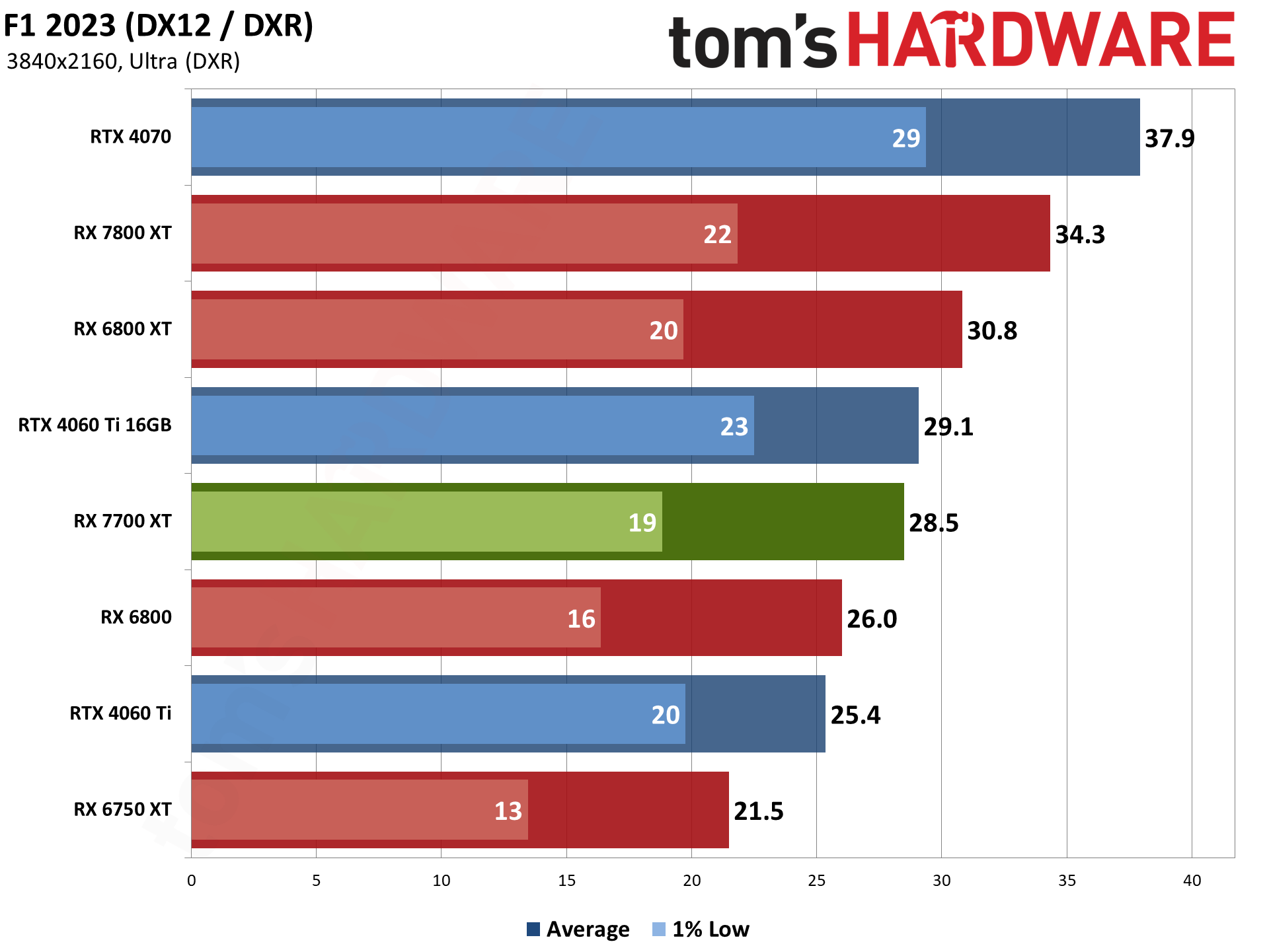
F1 2023 is a bit interesting in that the presets disable ray tracing at anything besides the ultra preset, so we get results that mirror what we saw in our rasterization and ray tracing suites, depending on the settings used. For reference, we tested on the Australia track, in the rain, for one loop of the track (130 seconds).
At 1080p medium, the RX 7700 XT beats the RTX 4060 Ti by 20%. That shrinks to just 3% at 1080p and 1% at 1440p, basically tied, thanks to the ray tracing effects. But then at 4K ultra, the AMD lead grows to 12% as the 8GB card starts to run out of memory. That doesn't happen with the 4060 Ti 16GB, though with both cards sitting at 29 fps, it's a bit of a pyrrhic victory for the 16GB Nvidia card.
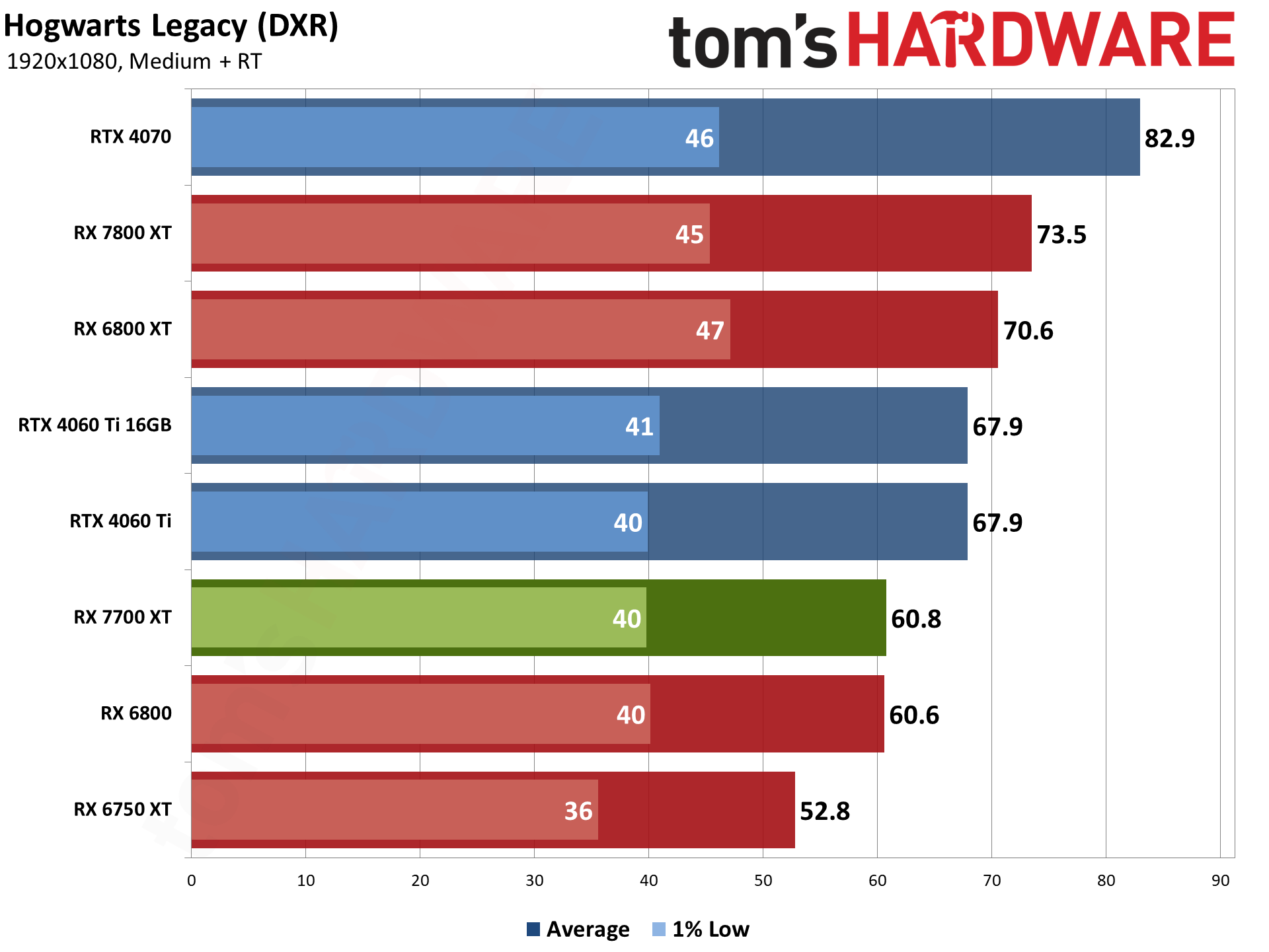
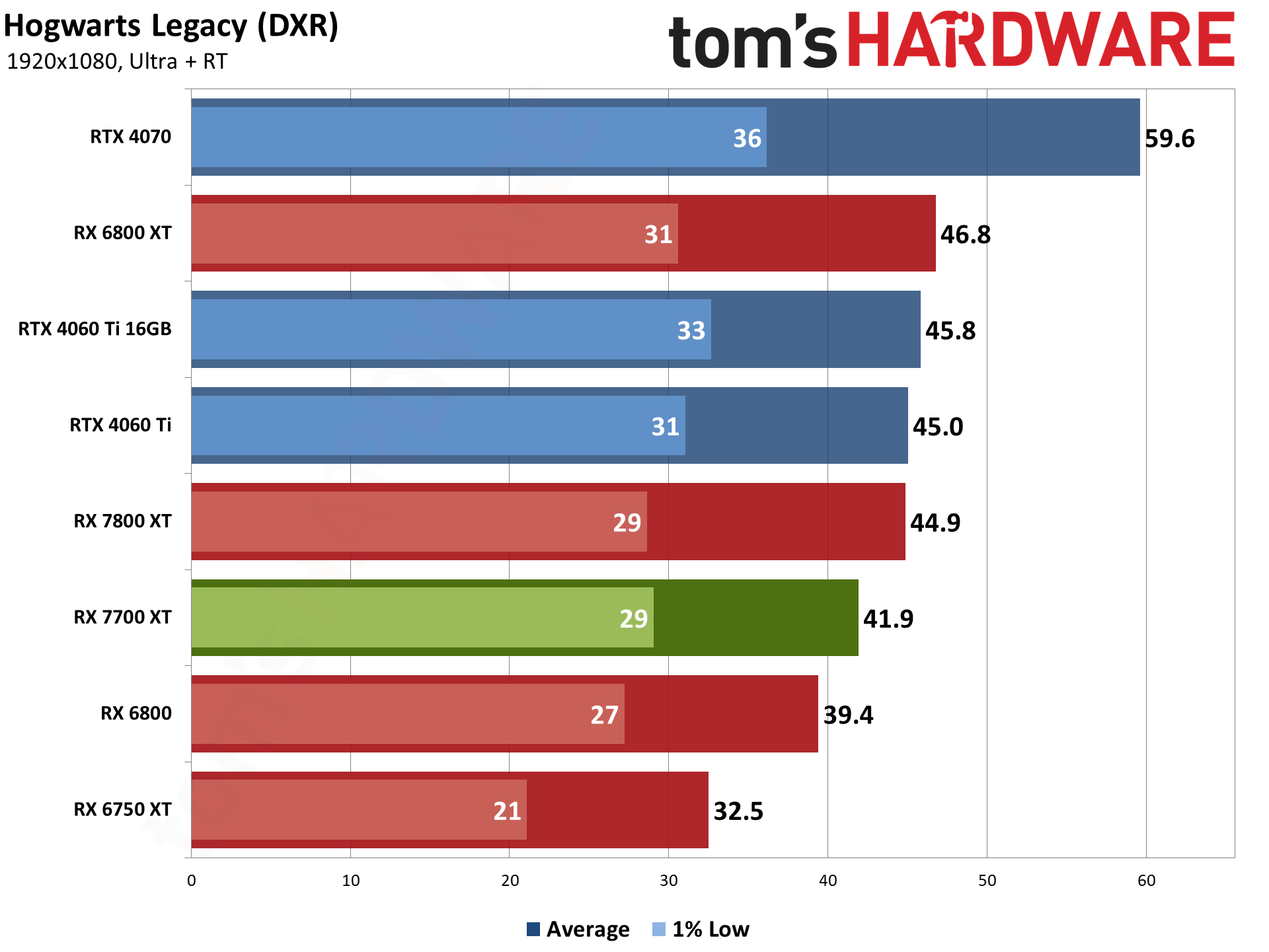
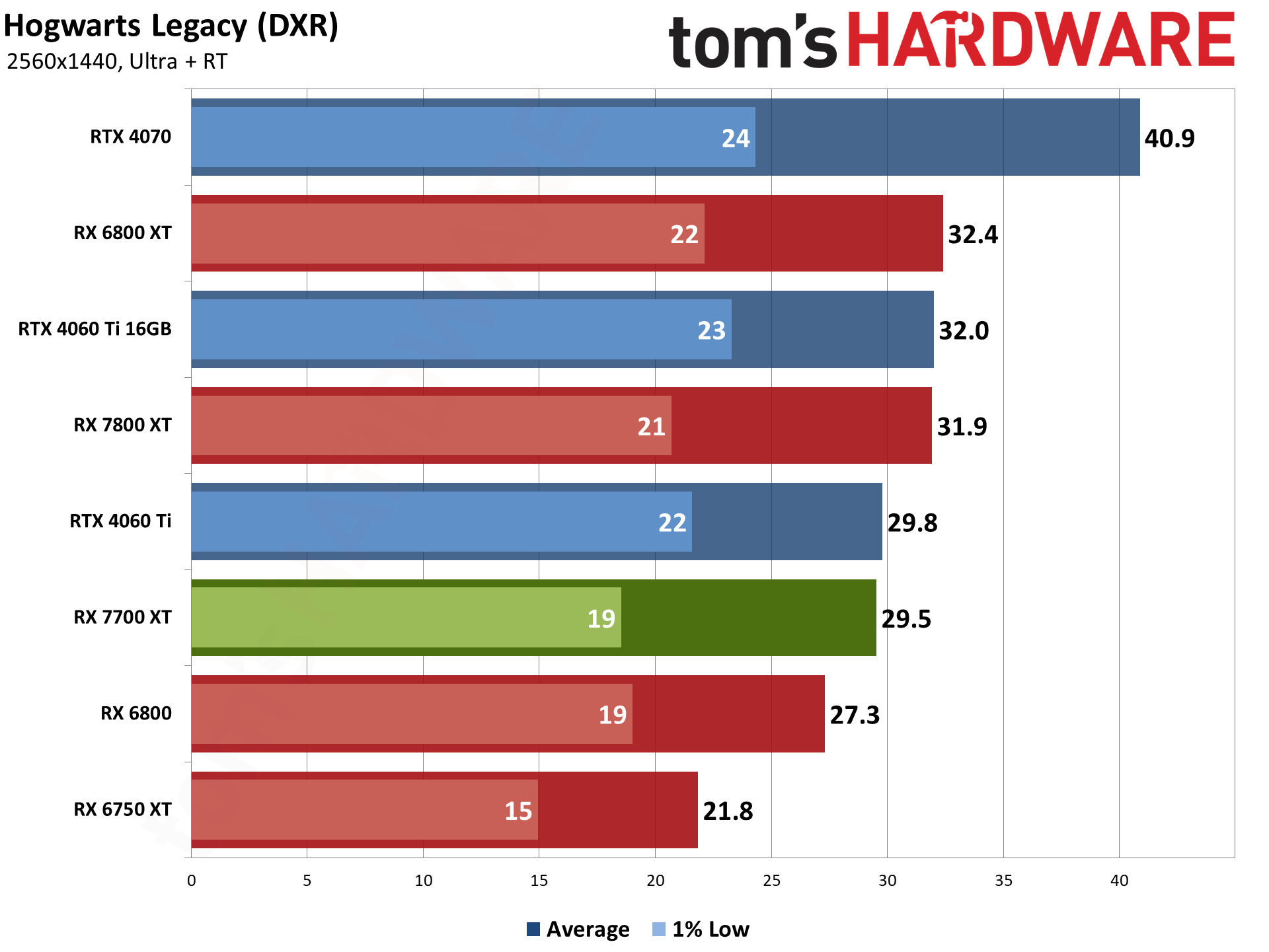
Hogwarts Legacy doesn't like running at maxed-out ultra settings on cards with only 8GB of VRAM, and even 12GB can be a problem at 1440p ultra with maxed-out ray tracing settings. The game will warn you about selecting settings that are too high, and then it will often crash to the desktop. We skipped the 4K testing due to the instability, not to mention performance would have been very poor on all of the GPUs. But we did manage to complete at least one benchmark run where needed.
For our 1080p medium settings, we have RT reflections, RT shadows, and RT ambient occlusion enabled, plus the overall RT quality set to medium. Our ultra settings use the ultra preset with all the RT effects enabled and RT quality set to ultra. As you'd expect, all of those ray tracing effects give the RTX 4060 Ti the lead over the RX 7700 XT.
Nvidia's RTX 4060 Ti 8GB card is 12% faster at 1080p medium, 7% faster at 1080p ultra, and basically tied (1% faster) at 1440p ultra. The 4060 Ti 16GB doesn't fall off a cliff at 1440p and maintains an 8% lead over the 7700 XT. Of course, both GPUs would benefit from enabling some level of upscaling, as 1440p otherwise dips below 30 fps at times.
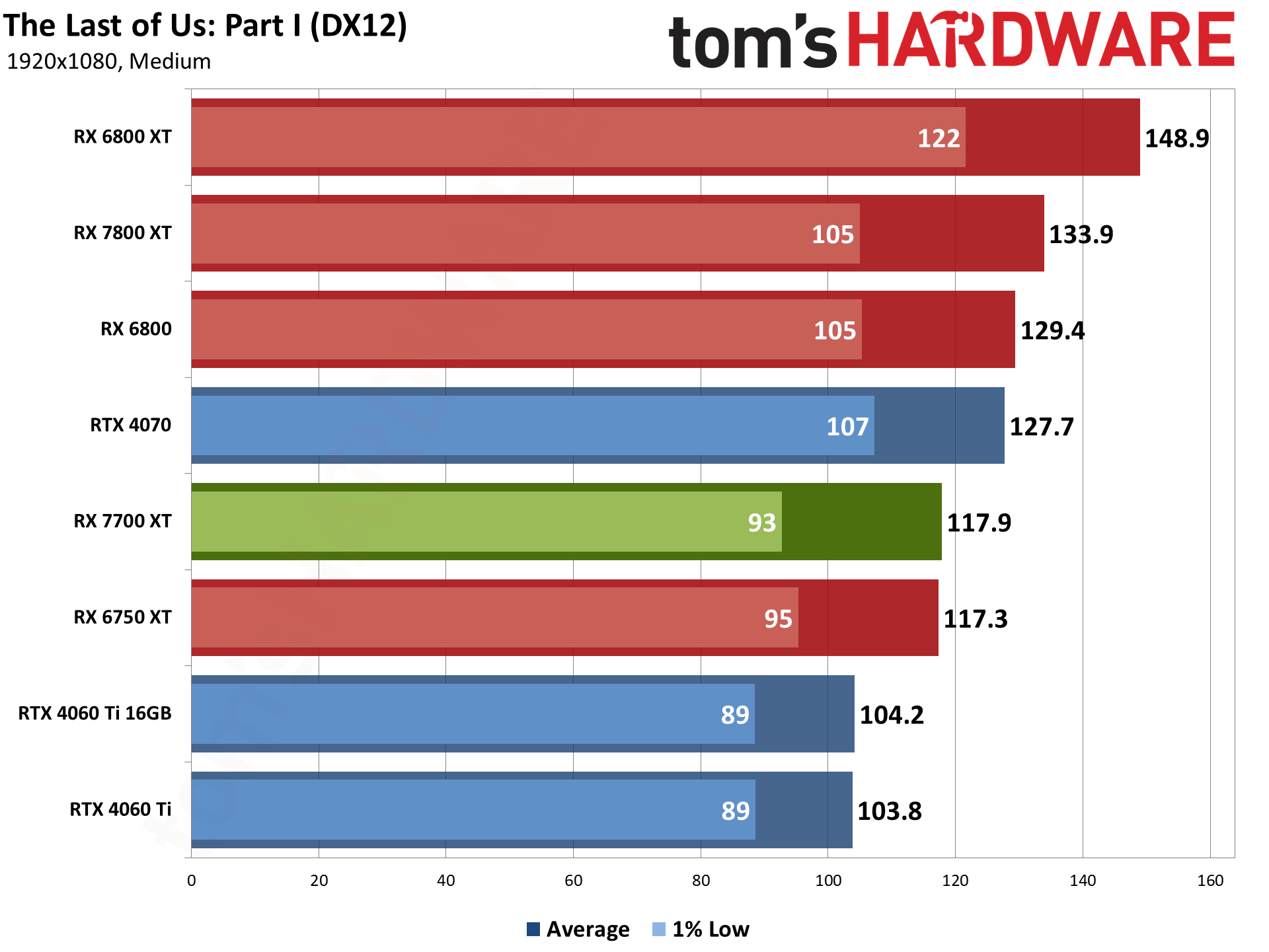
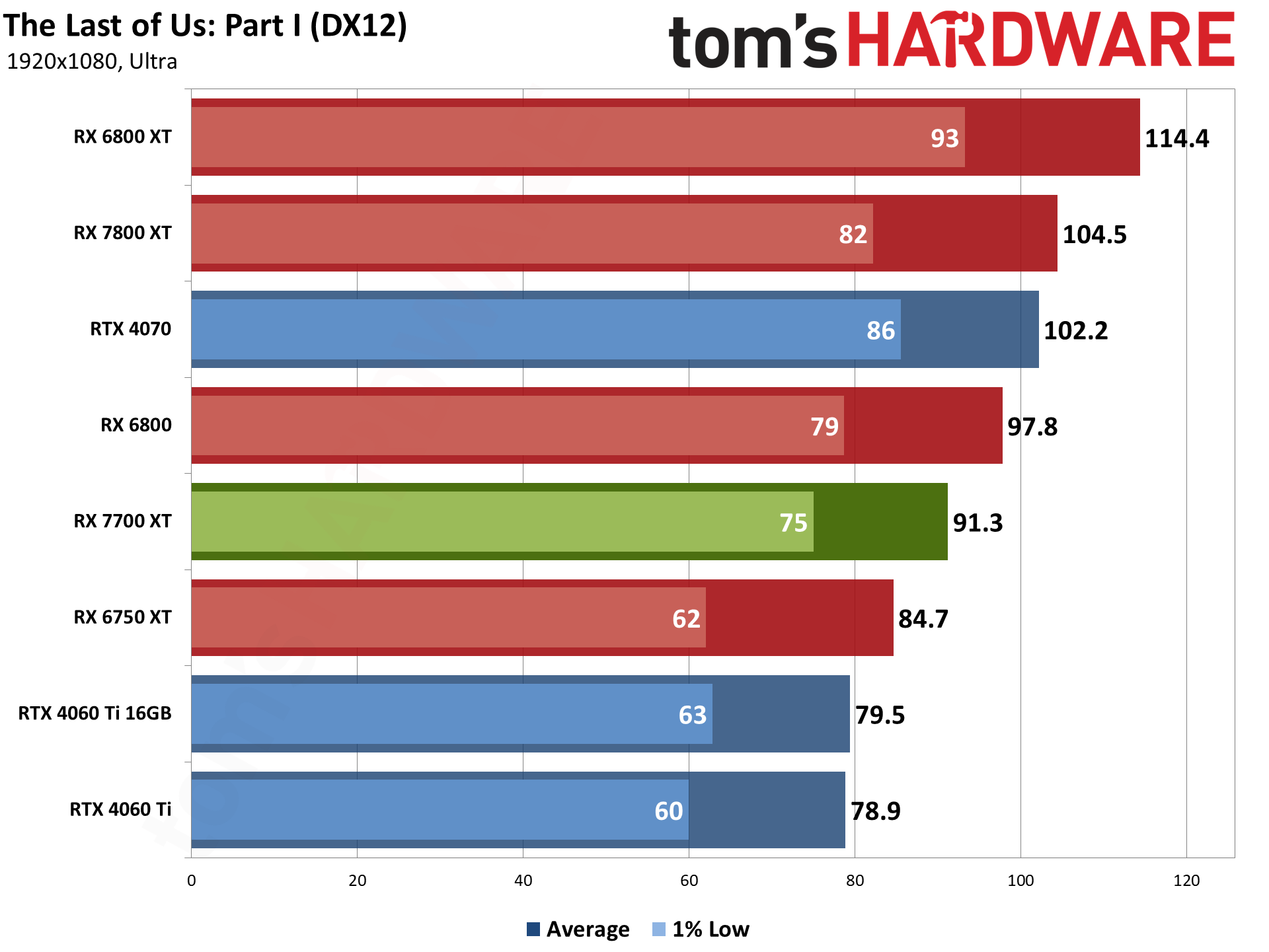
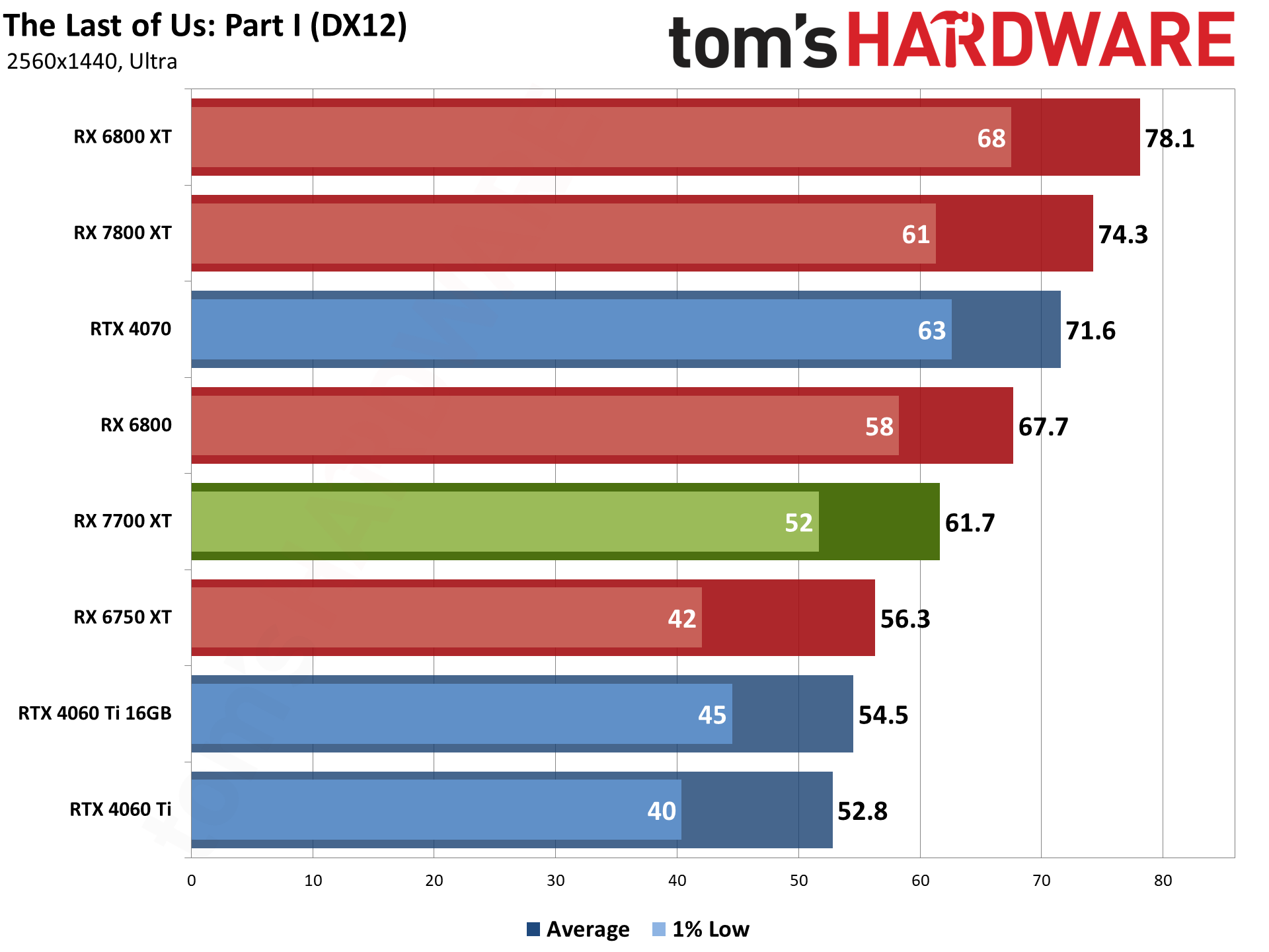
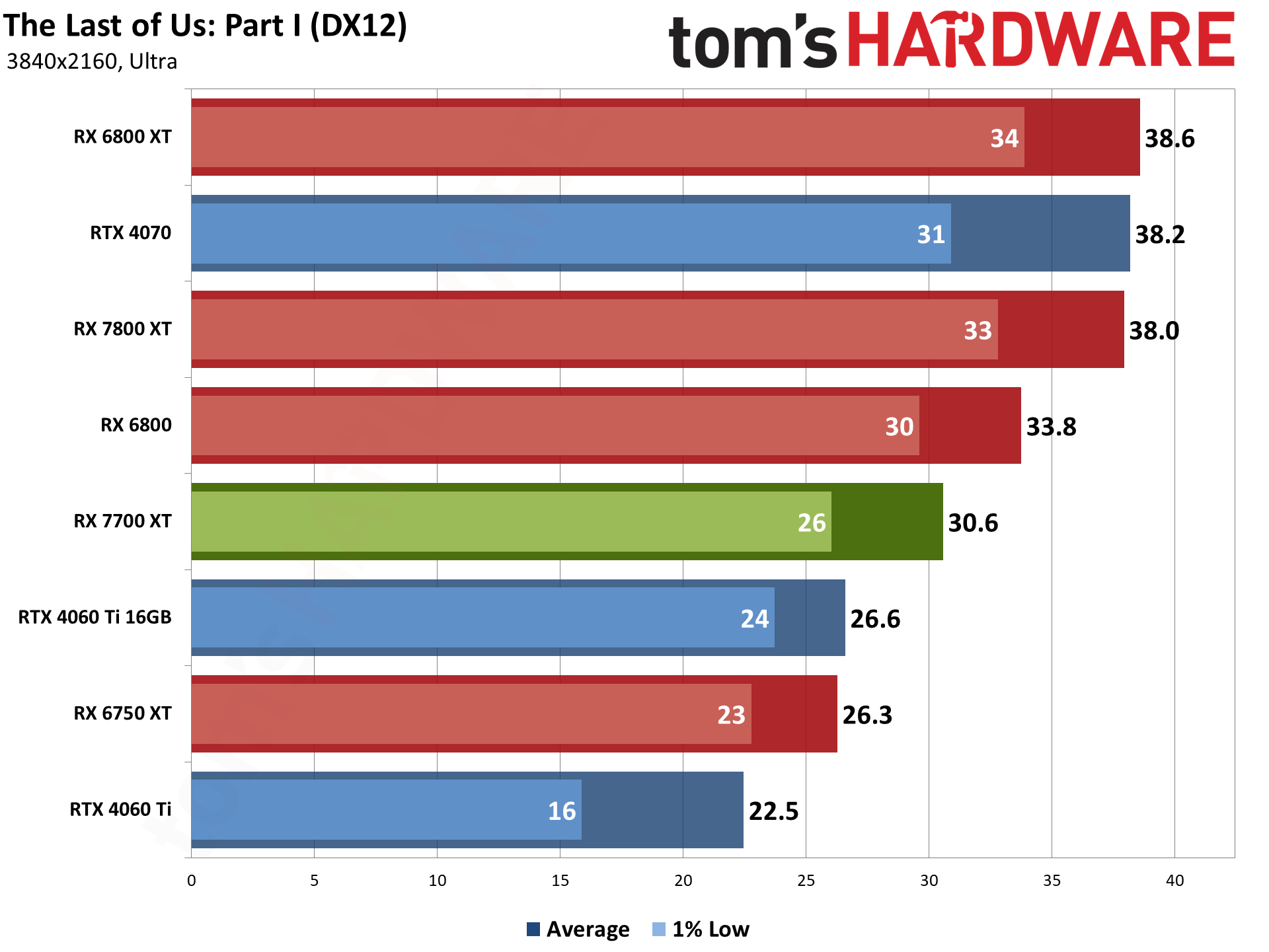
The Last of Us: Part I favors AMD's GPUs, and it's an AMD-promoted game. Using the medium and ultra presets, the RX 7700 XT is 14–17 percent faster than the RTX 4060 Ti 8GB at 1080p and 1440p, and then the lead grows to 36% at 4K when the 8GB card runs out of VRAM.
The RTX 4060 Ti 16GB doesn't have that problem, naturally, and so the 7700 XT lead falls in the 13–15 percent range at all tested resolutions and settings.
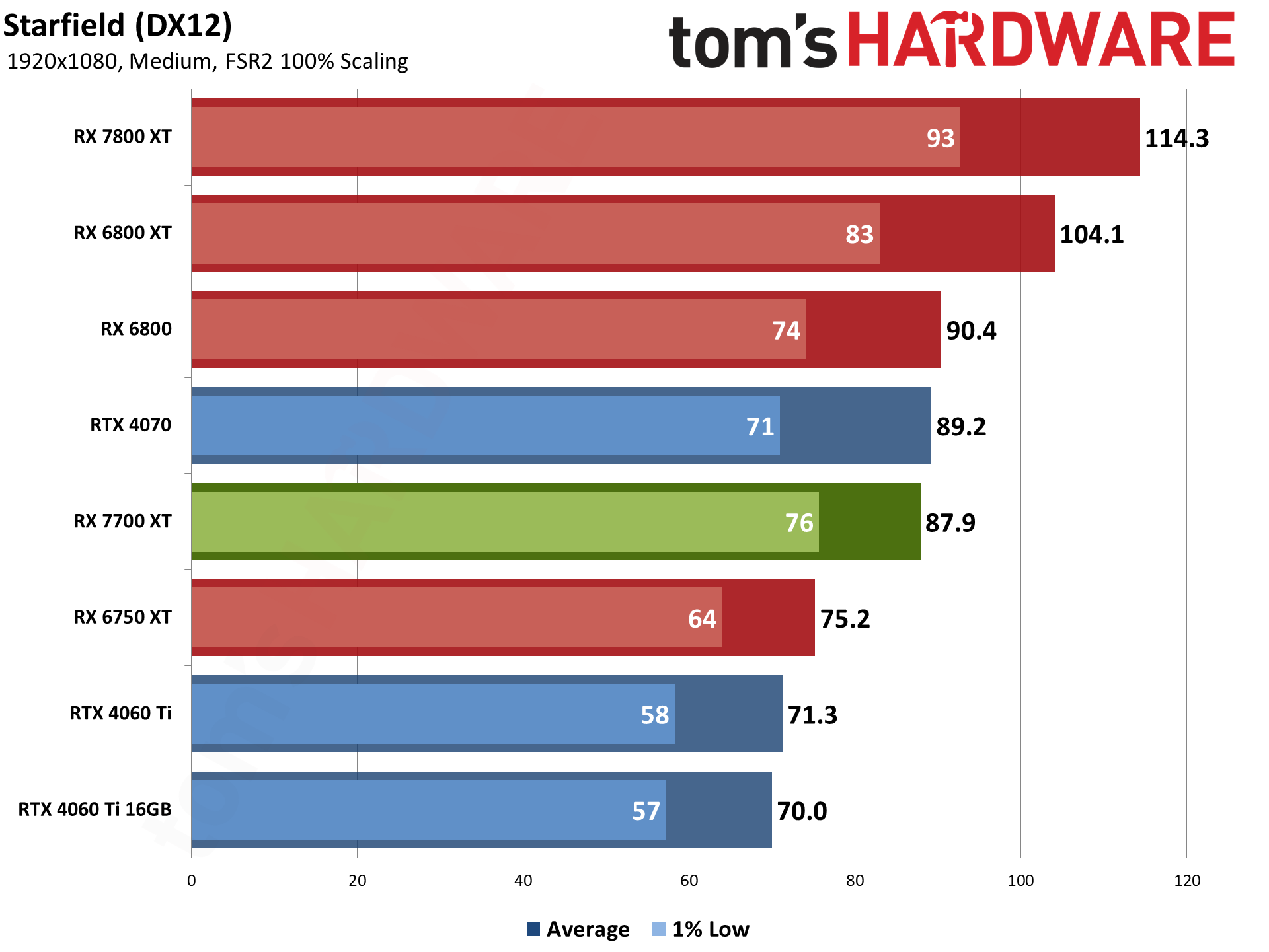
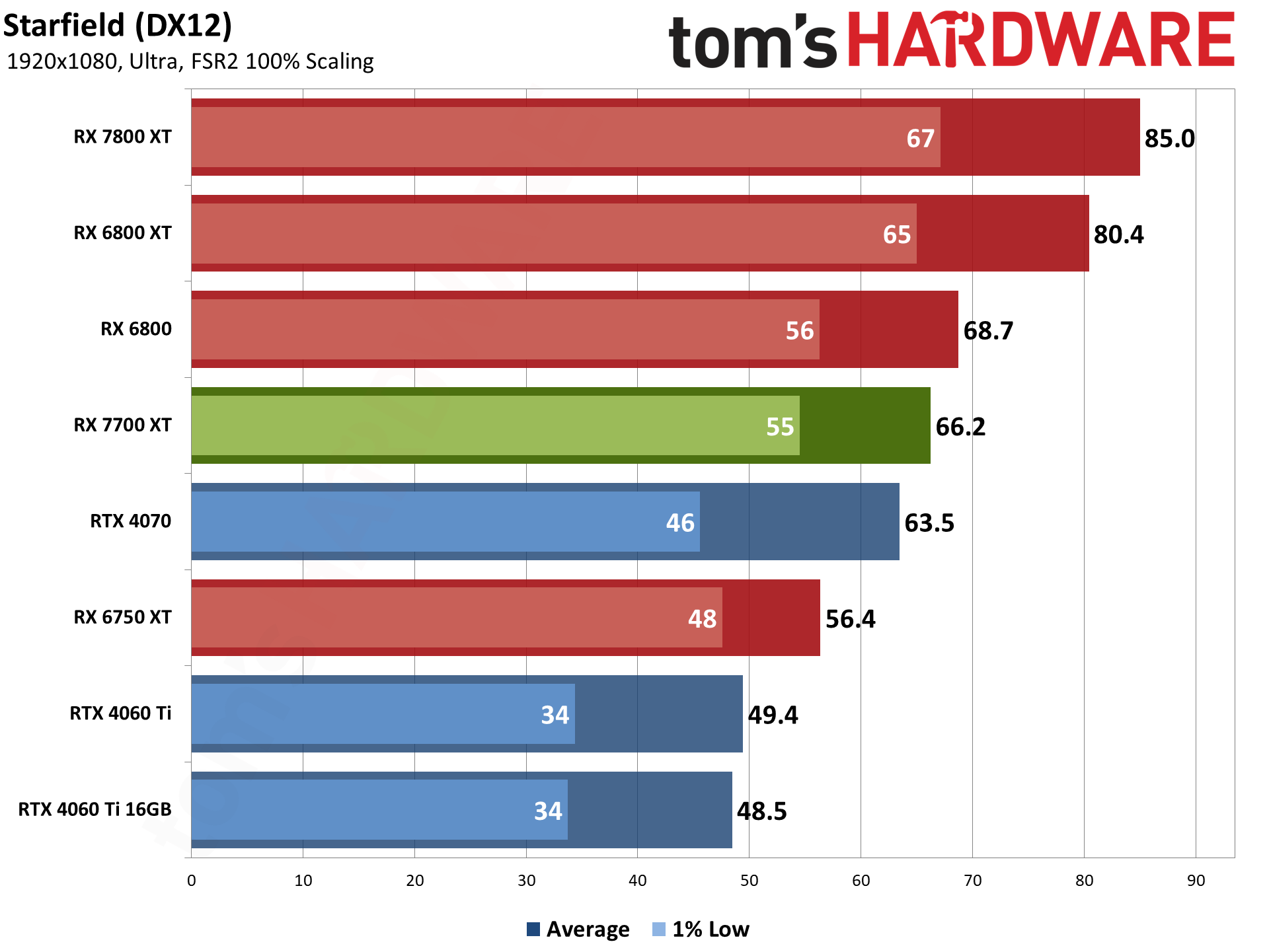
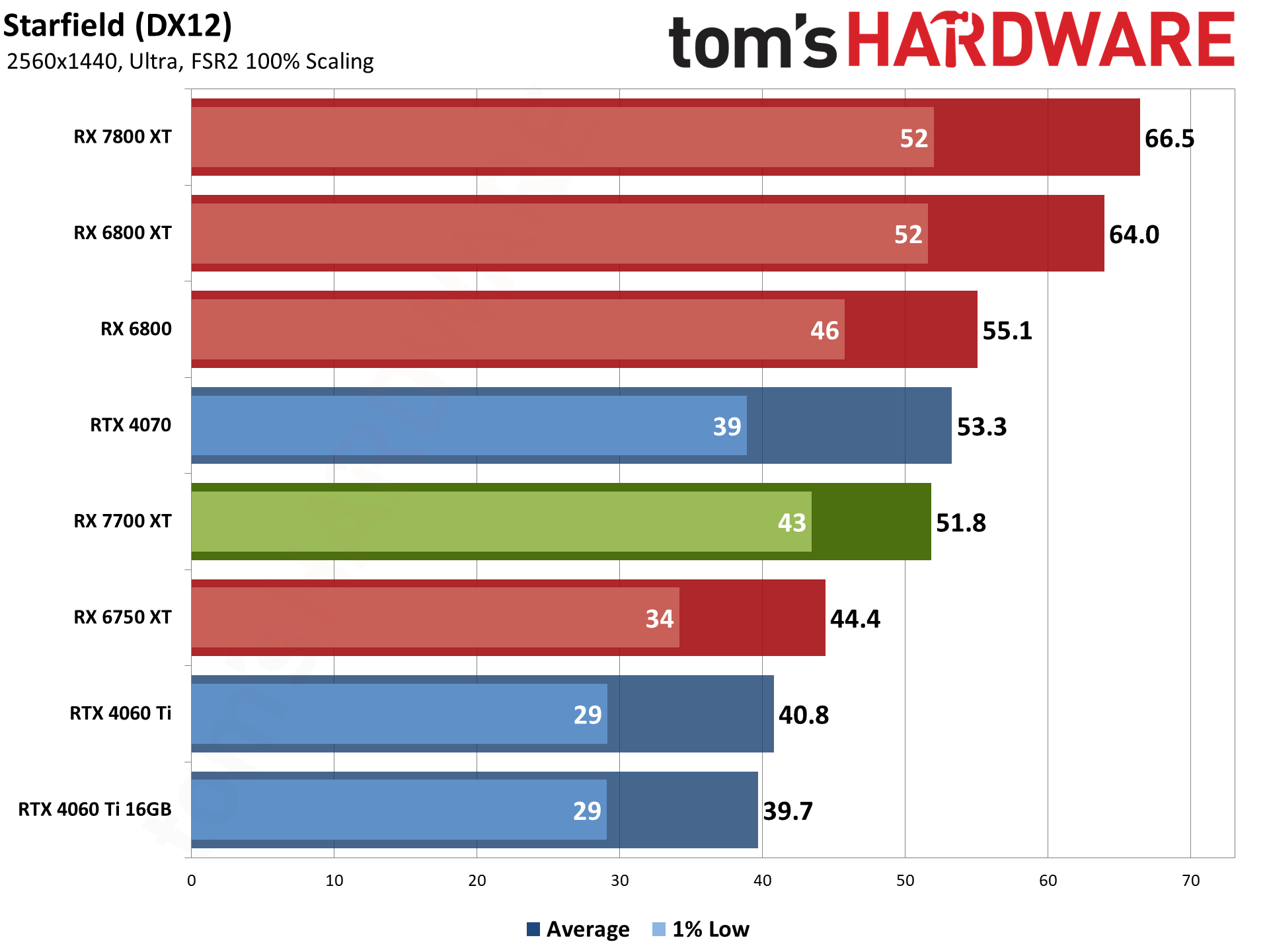
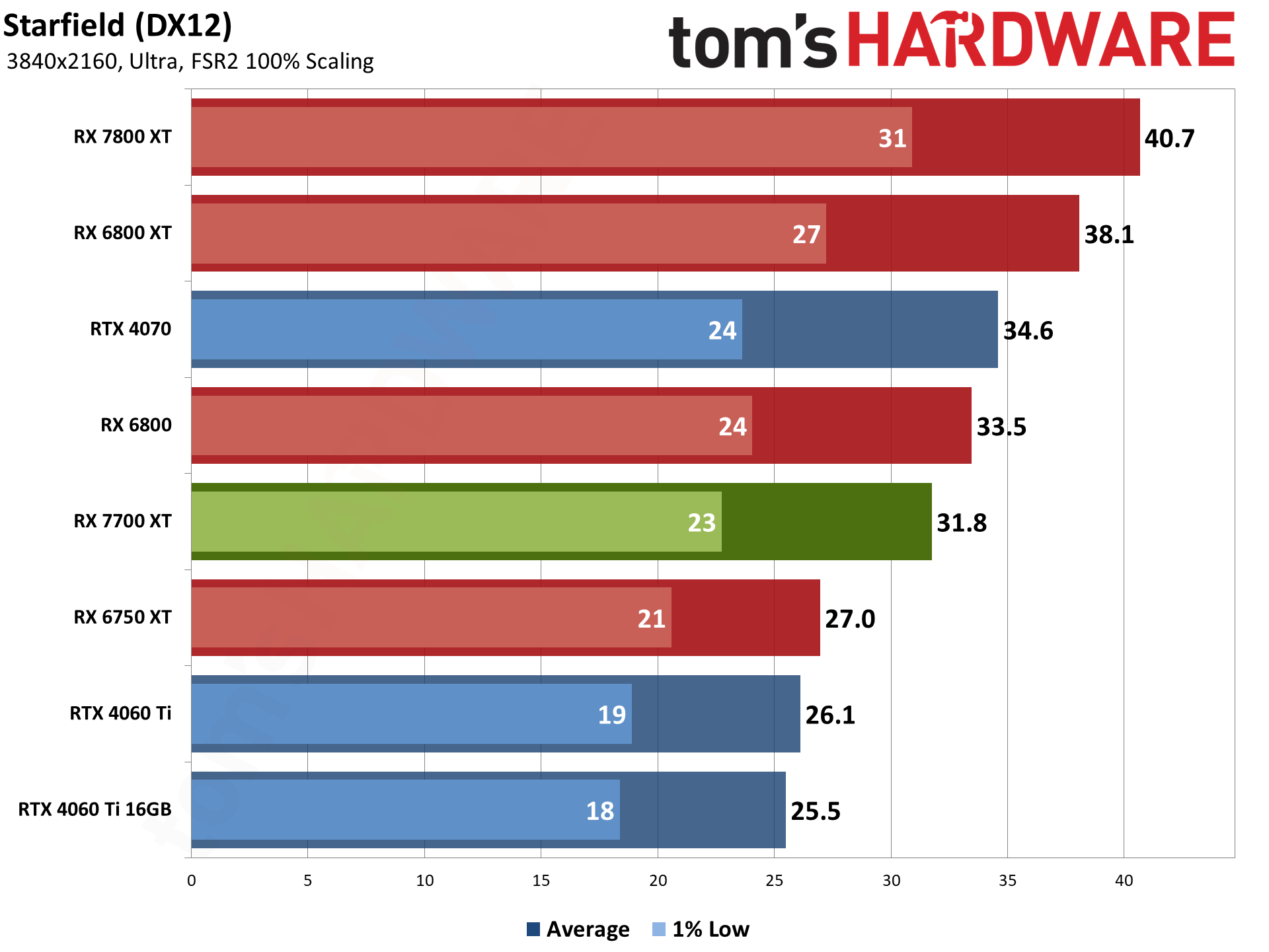
Last is Starfield, a game that officially launches today (it's been in early access for purchasers of the premium edition for the past week). As we noted in our Starfield PC performance testing, there are clearly issues with non-AMD GPUs right now. Nvidia's GPUs aren't hitting their power limit and fall further behind than in other games.
The net result is that the RX 7700 XT beats the RTX 4060 Ti (8GB) by 22–34 percent. VRAM capacity doesn't factor in, as the 4060 Ti 16GB shows a similar 25–35 percent lead for AMD's 7700 XT.
We haven't mentioned the 7800 XT of late, so let's also point out that it's significantly faster than the 7700 XT — by around 30% across all tested resolutions and settings in Starfield. Whatever the game engine is doing, it definitely seems to appreciate raw memory bandwidth.
- MORE: Best Graphics Cards
- MORE: GPU Benchmarks and Hierarchy
- MORE: All Graphics Content
Get Tom's Hardware's best news and in-depth reviews, straight to your inbox.
Current page: Radeon RX 7700 XT: Bonus Gaming Tests
Prev Page Radeon RX 7700 XT: 4K Ultra Gaming Performance Next Page Radeon RX 7700 XT: Professional Content Creation and AI Performance
Jarred Walton is a senior editor at Tom's Hardware focusing on everything GPU. He has been working as a tech journalist since 2004, writing for AnandTech, Maximum PC, and PC Gamer. From the first S3 Virge '3D decelerators' to today's GPUs, Jarred keeps up with all the latest graphics trends and is the one to ask about game performance.
-
cknobman This card will be a winner when the price is reduced to $400.Reply
Between this card and its bigger brother, the 7800XT, Nvidia's 4060 series of cards (and maybe even the 4070) are completely irrelevant now. -
oofdragon Replycknobman said:This card will be a winner when the price is reduced to $400.
Between this card and its bigger brother, the 7800XT, Nvidia's 4060 series of cards (and maybe even the 4070) are completely irrelevant now.
I'd say the 7800XT will be a winner in a year or two when it's discounted at $400. The 7700XT at 12GB is more like.. $300. -
Colif Both cards released make the 4060 TI even more of a joke than it was already.Reply
5TGHvXKkhao
The price difference is bigger in other countries, it makes more sense there.
7800xt in Australia is about $1000
7700xt in Australia is about 860
7800xt selling out fast so 7700xt might be only choice for a few weeks in some places. -
JarredWaltonGPU Reply
Does it, though?Colif said:Both cards released make the 4060 TI even more of a joke than it was already.
The price difference is bigger in other countries, it makes more sense there.
7800xt in Australia is about $1000
7700xt in Australia is about 860
7800xt selling out fast so 7700xt might be only choice for a few weeks in some places.
272
So 20% faster in rasterization, 8–10 percent slower in DXR, uses 60W more power, costs 12.5% more. The 128-bit and 8GB is a concern, sure, but it's absolutely not the end of the world. Turn down settings to high and it's fine, even at 1440p.
7800 XT makes for a bigger gap, and that's definitely the better card of the 4060 Ti/7700 XT/7800 XT class. But the 7700 XT isn't a clear-cut winner in every situation: Higher power, worse RT, worse AI hardware, higher cost. -
P1nky Reply
Can't believe you're actually defending the 4060 Ti, a GPU with just 8GB for a massive $400 price. No wonder you gave the 7700 XT a meh rating.JarredWaltonGPU said:So 20% faster in rasterization, 8–10 percent slower in DXR, uses 60W more power, costs 12.5% more. The 128-bit and 8GB is a concern, sure, but it's absolutely not the end of the world. Turn down settings to high and it's fine, even at 1440p.
7800 XT makes for a bigger gap, and that's definitely the better card of the 4060 Ti/7700 XT/7800 XT class. But the 7700 XT isn't a clear-cut winner in every situation: Higher power, worse RT, worse AI hardware, higher cost.
You must watch HU's investigation of how bad the textures look on just 8GB, even if the framerates are unaffected. There are plenty of games that won't be bottlenecked by 8GB by 30 second benchmark runs. Cards might performs similarly sometimes, but the texture experience and frame drops on on 4060 Ti are a joke on long benchmark runs. -
luissantos ReplyJarredWaltonGPU said:So 20% faster in rasterization, 8–10 percent slower in DXR, uses 60W more power, costs 12.5% more. The 128-bit and 8GB is a concern, sure, but it's absolutely not the end of the world. Turn down settings to high and it's fine, even at 1440p.
7800 XT makes for a bigger gap, and that's definitely the better card of the 4060 Ti/7700 XT/7800 XT class. But the 7700 XT isn't a clear-cut winner in every situation: Higher power, worse RT, worse AI hardware, higher cost.
Your only valid point is power consumption.
DXR performance is mostly irrelevant: neither card is sufficiently capable in that regard. Until DXR comes with a 5-10% penalty in performance it will remain a gimmick. In fact, games that have had a "modern render release" like Quake 2 look far better using said new render than DXR. For CP2077 I'm sure I could find plenty of scenes where I could take a screenshot with RT on and off and trick you into guessing incorrectly. Moreover, UE 5's Lumi produces reasonably similar results with RT on and off, and that engine will have the most coverage of any other in the game market for the years to come.
As for AI, just a few weeks ago AMD announced huge strides in that field as well, but again, that's irrelevant. What percentage of the market is buying a consumer mid-range GPU to focus primarily (or at all) on AI? -
JarredWaltonGPU Reply
The texture stuff is mostly game specific. Some games (Gollum, Star Wars, and basically a lot of Unreal Engine stuff) do a poor job at managing VRAM and so when the game exceeds 8GB, they load minimum res on some surfaces and not others. Then you get "texture popping" and stuttering. It's frankly a bad game engine design. Lots of other games exist that look very good and don't have the same problem, so it's pretty much a matter of coding quality and effort.P1nky said:Can't believe you're actually defending the 4060 Ti, a GPU with just 8GB for a massive $400 price. No wonder you gave the 7700 XT a meh rating.
You must watch HU's investigation of how bad the textures look on just 8GB, even if the framerates are unaffected. There are plenty of games that won't be bottlenecked by 8GB by 30 second benchmark runs. Cards might performs similarly sometimes, but the texture experience and frame drops on on 4060 Ti are a joke on long benchmark runs.
The solution is to turn texture and shadow resolution down a notch, which usually drops VRAM use from <12GB to <8GB and rarely has a noticeable impact on visuals. Except some games (again, UE especially) don't even seem to do this very well. Software optimizations, particularly with low-level APIs (DX12/Vulkan) can easily deliver a 50% boost in performance, sometimes more. It's just a matter of how much effort the developers / publishers want to expend.
I’m not saying 4060 Ti is great. I’m just pointing out that it’s not universally inferior to the 7700 XT / 7800 XT. 192-bit and 12GB or 256-bit and 16GB is inherently a superior configuration to 128-bit and 8GB/16GB. There's no question about that. But VRAM capacity and bandwidth aren't the only factor that matters. -
shady28 Agree this isn't all that impressive, but neither was the 4060 Ti. I bought a 6700XT last year, and after seeing the 4060 Ti I really have no regrets.Reply
This 7700XT doesn't really seem to change any of that. If it were say $399 instead of $450, it might be ok. It's kind of a trade off with the 4060 Ti, generally better on performance (but not always) while losing on gaming power draw, but costs $50 more, which is frankly not good enough for an AMD GPU.
Best deal on your comparison is still the 6700 XT. -
Ilijas Ramic Reply
In my country the price diff is around 140usd 7700xt vs 7800xt. I ordered 7700xt for 680usd while the 7800xt is 820usd. Its almost 3x more price diff what most people pay. Also most people buy from newegg since they are from US. But us EU people are getting a hefty pay up on these card. Heck the newegg price is 450usd for 7700xt while i have to pay 230usd more. I havent upgraded my gpu for like 8 years now. Heck i got r9 380 on release date. And i paid back than msrp US price here wich was shocking 200usd. But after that we got price diffs soo large i just couldnt afford to upgrade.Colif said:Both cards released make the 4060 TI even more of a joke than it was already.
5TGHvXKkhao
The price difference is bigger in other countries, it makes more sense there.
7800xt in Australia is about $1000
7700xt in Australia is about 860
7800xt selling out fast so 7700xt might be only choice for a few weeks in some places.
